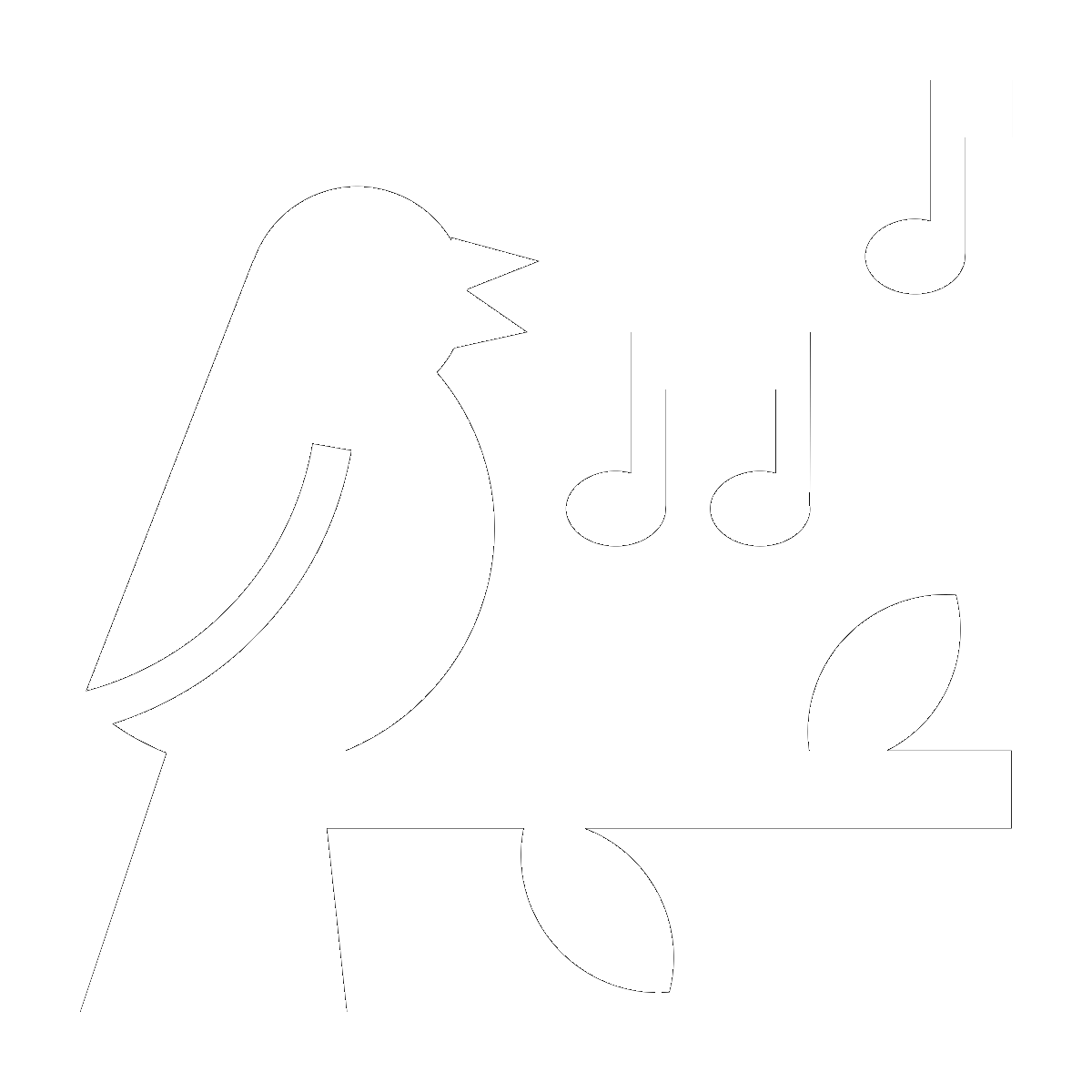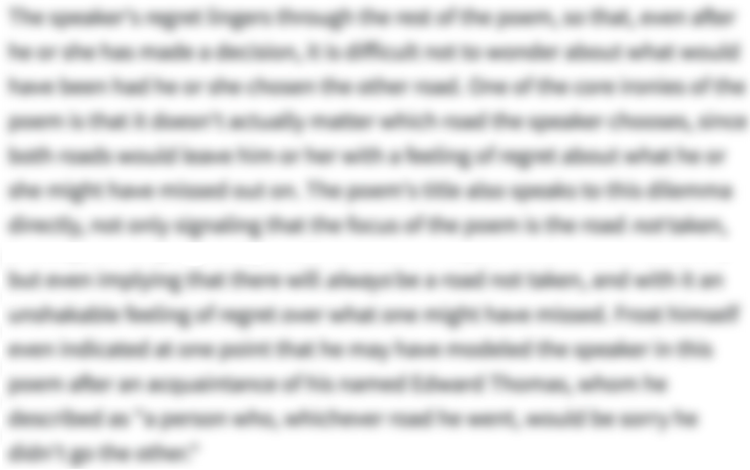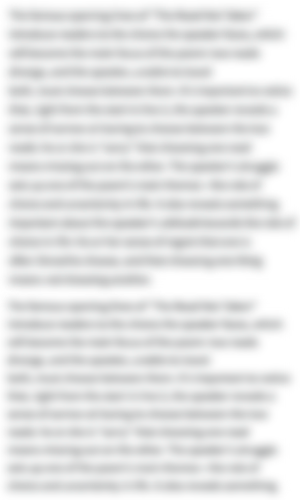The Full Text of “I have a Bird in spring”
1I have a Bird in spring
2Which for myself doth sing—
3The spring decoys.
4And as the summer nears—
5And as the Rose appears,
6Robin is gone.
7Yet do I not repine
8Knowing that Bird of mine
9Though flown—
10Learneth beyond the sea
11Melody new for me
12And will return.
13Fast in a safer hand
14Held in a truer Land
15Are mine—
16And though they now depart
17Tell I my doubting heart
18They're thine.
19In a serener Bright,
20In a more golden light
21I see
22Each little doubt and fear,
23Each little discord here
24Removed.
25Then will I not repine,
26Knowing that Bird of mine
27Though flown
28Shall in a distant tree
29Bright melody for me
30Return.
-
“I have a Bird in spring” Introduction
-
"I have a Bird in spring," in which a speaker tries to hang onto the faith that a beloved songbird will return in spite of the fact that it's flown far away, expresses the difficulty of facing loss in love and explores the strength it takes to go on trusting in a changed relationship. Emily Dickinson included the poem in an 1854 letter to her beloved Sue Gilbert, a friend to whom she'd developed a passionate attachment. When Sue married Dickinson's brother Austin, Dickinson had to grapple with the possibility that her relationships with two people she cared deeply about might never be the same. Like the vast majority of Dickinson's work, this poem wasn't published until long after her death. It was first printed in an 1894 collection of her letters.
-
-
“I have a Bird in spring” Summary
-
In the springtime, I have a bird that sings to me. But the spring is deceptive. When summer comes and the roses bloom, my robin disappears.
Still, I don't mourn. I know that my bird, though it's flown away, is learning new songs for me far away beyond the sea, and will come back.
Safe in a secure hand, resting in a more authentic place, are my birds. Though they leave me now, I tell my uncertain heart that they're still mine.
In a calmer, more golden light, I see all of my little fears, anxieties, and troubles vanish.
So I won't mourn, since I know that my bird—though it's flown away—will sing in a faraway tree and bring back a bright song for me.
-
-
“I have a Bird in spring” Themes
-

Separation and Faith
The speaker of “I have a Bird in spring” rejoices in the company of a little songbird in the springtime. But when summer comes, the bird flies away, and the speaker is left lonely. The only way the speaker can go on is to teach their “doubting heart” to believe that their bird “will return” in spite of their fears. For this speaker, enduring a separation means leaning on faith, trying to trust that what you love will someday come back to you.
Listening to their beloved bird singing in the springtime, the speaker seems once to have felt that this happy relationship would go on just like this forever. But, alas, “the spring decoys” (or misleads): what seems permanent in springtime changes “as the summer nears,” when the bird takes off for parts unknown. This separation strikes the speaker to the heart.
To cope with losing their bird, the speaker must rely on faith. First, they must trust that that the bird is still “mine,” still deeply connected to them even when it’s far away. Second, they must hang onto the belief that the bird “will return,” that this separation won’t be final.
Keeping the faith like this is difficult. In order not to “repine” (that is, mourn) and despair, the speaker needs to rely on the thought of a “more golden light,” a heavenly kind of illumination and understanding, that can wash away “each little doubt and fear” they feel about their bird. In other words, they have to reach out imaginatively to a kind of divine wisdom in order to maintain their hope that what they’ve lost will return.
Suffering a separation from something (or someone) you love, this poem thus suggests, is a great trial—and keeping the faith in your connection to a faraway beloved takes proportionately great fortitude, imagination, and trust.
- See where this theme is active in the poem.
-

Inspiration and Creativity
This poem’s tale of a little bird who sings to the poem’s speaker in spring and disappears in the summer might be read as an image of the rhythms of an artist’s life. When this bird is with the speaker, it sings beautifully; when it disappears, the speaker can only wait patiently, trying not to be too anxious, knowing that the bird will bring “melody new” with it when it returns. Poetic inspiration might work in just this way: the poet sometimes just has to sit and wait through a quiet spell until the music comes back again, trusting that their gift won’t abandon them.
Though they do their best to bear it, the poem’s speaker is clearly heartbroken when the little bird they love flies away. They feel shaken with “doubt and fear,” worried that their bird will never return to them. The image of being suddenly deprived of a musical companion might suggest a poet’s feelings when they run into a dry patch and find they can’t “hear” the melody of their poetry any more.
But this speaker is able to stay brave by having faith that their little bird is just storing up “melody new,” making up fresh songs to sing when it returns. Since the bird disappears as the seasons change from spring to summer, perhaps its departure is just part of the natural cycle of creativity: maybe the bird has to fly away in order to come back with fresh songs.
Though the speaker feels all the anxiety of an artist who isn’t making art, then, they find comfort in the belief that inspiration will return and they’ll overflow with “bright melody” again someday. Perhaps they aren’t altogether at ease with the situation, but they can do their best to trust that their voice, like a migratory bird, will always come back eventually.
- See where this theme is active in the poem.
-
-
Line-by-Line Explanation & Analysis of “I have a Bird in spring”
-
Lines 1-6
I have a Bird in spring
Which for myself doth sing—
The spring decoys.
And as the summer nears—
And as the Rose appears,
Robin is gone.The first stanza of "I have a Bird in spring" tells the story of a joy cut short. In spring, the speaker says, they had a little bird that sung to them. But "the spring decoys": that is, that happy season only deceives the speaker. As spring turns to summer, their bird up and flies away.
The poem's very shape suggests that the speaker's time with their bird was painfully brief. The speaker and bird only share the poem's two first lines before the summer comes and "Robin is gone."
Worse, the speaker is left all alone in the summer, when the "Rose appears," a symbolic time of blossoming joy. The deceptive, decoying spring feels all the more wrong-footing because it should lead into a happy summer—and doesn't.
Even the poem's rhythms jar. Listen to the meter in the first lines:
I have | a Bird | in spring
Which for | myself | doth sing—
The spring | decoys.That short third line cuts off a pattern of neat iambic trimeter (that is, lines of three iambs, metrical feet with a da-DUM rhythm) at the knees. Though the poem won't stick to those iambic feet all the way through, it will keep moving back and forth between longer lines of three beats and shorter lines of only one or two beats, a halting rhythm that evokes a struggling, faltering voice.
Everything about this first stanza, then, suggests that the bird's departure broke the speaker's heart when they were least expecting it. This will be a poem about how on earth one can cope with the shock of separation from a beloved. For now, all the stunned speaker can say is that "Robin is gone"—a line whose soft /au/ assonance sounds like a quiet moan.
-
Lines 7-12
Yet do I not repine
Knowing that Bird of mine
Though flown—
Learneth beyond the sea
Melody new for me
And will return.

Unlock all 352 words of this analysis of Lines 7-12 of “I have a Bird in spring,” and get the Line-by-Line Analysis for every poem we cover.
Plus so much more...
Get LitCharts A+ -
Lines 13-18
Fast in a safer hand
Held in a truer Land
Are mine—
And though they now depart
Tell I my doubting heart
They're thine. -
Lines 19-24
In a serener Bright,
In a more golden light
I see
Each little doubt and fear,
Each little discord here
Removed. -
Lines 25-30
Then will I not repine,
Knowing that Bird of mine
Though flown
Shall in a distant tree
Bright melody for me
Return.
-
-
“I have a Bird in spring” Symbols
-

The Bird
The lost bird here might symbolize both a faraway beloved and departed poetic inspiration.
Dickinson wrote this poem while grappling with her feelings about Sue Gilbert, a woman she loved—and who married Dickinson's brother. The bird here can be read as standing in for Sue herself, flying off to the new adventure of marriage. The speaker, a voice for Dickinson in this reading, stays behind, trying her best to believe that her beloved will go on caring for her even with this change in circumstances. One doesn't need that biographical detail to read the bird here as a symbol of any lost beloved, though—anyone a mournful lover might hope to stay connected to even when they're far away, living another life.
With its lovely song, the bird might also represent artistic inspiration and creativity (a role songbirds have often played in poetry). When it departs, the anxious artist can only wait patiently for it to return, hopeful it might bring "melody new" with it.
- See where this symbol appears in the poem.
-
-
“I have a Bird in spring” Poetic Devices & Figurative Language
-
Repetition
Repetitions—especially strong parallelism—give this poem its shape and its tone. Steady, echoing sentence structures evoke the speaker's struggle to stay firm and faithful in the face of doubt and loss.
Much of the parallelism in the poem travels in couplets, as in these moments of anaphora from the fourth stanza:
In a serener Bright,
In a more golden light
I see
Each little doubt and fear,
Each little discord here
Removed.The mirrored lines feel intense and poignant. The first couplet, which describes the calm, golden light of an unearthly wisdom, invites readers to linger on the speaker's imagery for a moment, basking in that glow. In the second couplet, the repeated phrasing stresses just how "little" the speaker's fears and doubts feel in that light.
Perhaps the strongest and most meaningful repetitions here are the echoes between the second and fifth stanzas. The fifth stanza repeats the phrasing of the second word for word—almost. That makes those few differences there are between the stanzas especially significant:
- The speaker starts the second stanza by declaring, "Yet I do not repine." When that line rolls around again in the fifth stanza, it's turned into "Then will I not repine"—a statement that's softer in some ways and firmer in others. Before, the speaker claimed they weren't mourning; now, they admit they are, but that they'll try hard not to.
- Where in the second stanza the flyaway bird is learning "melody new" somewhere "beyond the sea," in the fifth the bird sings "bright melody" in "a distant tree." The movement from the mysterious oversea journey to the solid thought of a tree—faraway but imaginable—suggests that the speaker is getting a firmer imaginative grasp on their bird even as they accept how far away it is.
- Finally, the closing line of the second stanza—"and will return"—concentrates down to the lone word "return" in the closing line of the fifth stanza; the poem concludes with the simplest possible statement of the speaker's deepest longing.
- See where this poetic device appears in the poem.
-
Imagery


Unlock all 245 words of this analysis of Imagery in “I have a Bird in spring,” and get the poetic device analyses for every poem we cover.
Plus so much more...
Get LitCharts A+ -
Assonance
-
Enjambment
-
-
“I have a Bird in spring” Vocabulary
Select any word below to get its definition in the context of the poem. The words are listed in the order in which they appear in the poem.
- Decoys
- Repine
- Learneth
- Fast
- Thine
- Discord
Decoys-
Here, Dickinson uses this word to mean "offers a false promise" or "misleads."
- See where this vocabulary word appears in the poem.
-
Form, Meter, & Rhyme Scheme of “I have a Bird in spring”
-
Form
Rather than turning to the ballad stanzas she so often used, Dickinson invents a form of her own here. Five six-line stanzas (or sestets) with a changeable meter track this speaker's efforts to see a loss in a "more golden light" of understanding.
The poem's changing line lengths and halting rhythms suggest that, though the speaker is resolved not to "repine" and grieve over being separated from a beloved songbird, they're still struggling with deep sorrow and anxiety. Some lines here are only one word long, truncated as if the speaker were choking back tears.
The poem's overall shape, though, is steady as the speaker's sense of purpose.
-
Meter
The poem's halting meter evokes the speaker's battle with doubt and grief. While often iambic—that is, built from iambs, metrical feet with a da-DUM rhythm, as in "I have | a Bird | in spring"—the lines unpredictably change shape and length, as if they're struggling.
Though the rhythm of the lines varies from stanza to stanza, there's still a pretty steady pattern here. Each stanza dances back and forth between couplets with three strong stresses and single lines with either one or two stresses. Listen to the fourth stanza, for instance:
In a serener Bright,
In a more golden light
I see
Each little doubt and fear,
Each little discord here
Removed.Though the two couplets don't exactly match each other, they consistently use those three strong beats; the shorter lines just have the one.
The poem's varied rhythms make the speaker's voice sound thoughtful and natural, not too rigorously structured. It's as if they're thinking through their dilemma in the moment.
-
Rhyme Scheme
"I have a Bird in spring" features a subtle rhyme scheme that changes slightly across the poem. Stanzas 2, 3, and 5 run like this:
AABCCB
The B rhymes that frame the couplets are often only the loosest possible slant rhymes (for instance, "flown" and "return" have only that /n/ consonance in common). The only perfect B rhyme appears in stanza 3, which pairs "mine" and "thine."
In stanzas 1 and 4, the pattern breaks completely: there's no firm link between "decoys" and "gone" or "see" and "removed." These stanzas rhyme:
AABCCD
This trip in the rhyme scheme might suggest the speaker's wobbling faith.
Overall, though, the poem's short B lines seem to hold hands, cutting across the firm and perfect couplets that make up the rest of each stanza. The mixture of chiming couplets and faint, loose B rhymes helps to set the poem's tone, mirroring the speaker's mingled faith and doubt.
-
-
“I have a Bird in spring” Speaker
-
There's cause to read the speaker in this poem as a version of Dickinson herself. Dickinson enclosed this poem in a letter to her beloved Sue Gilbert, a dear friend she had intense and passionate feelings for. Sue cared deeply for Emily, too—but married Emily's brother Austin. Dickinson wrote this letter not long after her brother and her beloved had decided to get engaged; in it, she tries desperately to reconcile herself to the situation.
Whether or not readers know about this context, though, they can get a sense of this speaker as a suffering but courageous soul. The speaker's insistence that they "do [...] not repine" at losing their bird gets undercut a little by their later resolution: "Then will I not repine." Clearly, they do grieve when their bird flies away. But they're also resolved to meet this loss with faith and hope, trusting in a "more golden light" of heavenly understanding that can and will relieve their sorrow—and trying hard to believe that their bird is still somehow theirs, even when it's flown far away.
-
-
“I have a Bird in spring” Setting
-
"I have a Bird in spring" could take place anywhere that spring rolls into summer. The poem plays with the usual symbolism of the seasons: summer, the warm and fertile time when "the Rose appears," is here an untraditional time of loss and grief. While it's a summer of change and excitement for the bird who flies away, the blooming season is practically a winter of discontent for the lonely speaker.
The other important element of the setting here is a sense of distance. The poem's speaker doesn't quite know where their beloved bird has flown away to—only that it's "beyond the sea," in some "distant tree" they can only faintly imagine. Trying to trust that they'll be reunited with their bird one day, they picture seeing their situation in a "more golden light," a heavenly image that hints the pain of separation and loss might only get smoothed out in the "serener Bright" of the afterlife.
-
-
Literary and Historical Context of “I have a Bird in spring”
Literary Context
Emily Dickinson (1830-1886) published almost nothing during her lifetime, and after 1865 she rarely even left her family home in Amherst, Massachusetts. But from within her circumscribed world, she explored the heights and depths of human experience through her groundbreaking poetry.
No one else sounds quite like Dickinson. Her poems use simple, folky forms—ballad stanzas, for instance—to explore profound philosophical questions, passionate loves, and the mysteries of nature. This poem was one of many that she wrote for the smallest of audiences: it was meant only for the eyes of her beloved friend Sue Gilbert. It didn't appear in print until 1894, when a selection of Dickinson's letters was posthumously published.
While Dickinson didn't get too involved in the literary world of her time, she was still part of a swell of 19th-century American innovation. Her contemporary Walt Whitman (who became as famous as Dickinson was obscure) was similarly developing an unprecedented and unique poetic voice, and the Transcendentalists (like Emerson and Thoreau) shared her deep belief in the spiritual power of nature.
Dickinson herself was inspired by English writers like William Wordsworth and Charlotte Brontë, whose works similarly found paths through the everyday world into the sublime, terrifying, and astonishing.
After Dickinson died, her sister Lavinia discovered a trunk of nearly 1,800 secret poems squirreled away in a bedroom. Published at last, Dickinson's poetry became internationally famous and beloved. Dickinson's work and her life story still influence all kinds of artists.
Historical Context
This poem responds to a difficult episode in Dickinson's life: the marriage between her brother Austin and her beloved friend Sue Gilbert. Emily, Austin, and Sue met in their twenties, when the orphaned Sue moved to the Dickinsons' native Amherst to live with her elder sister. Emily and Sue took to each other right away. Sue, like Emily, had a brilliant intellect and a wide-ranging curiosity, and the pair felt like kindred spirits in a world that didn't make much room for thinking women.
When Sue spent time away working as a teacher, Emily missed her badly and wrote her increasingly passionate letters. Sue would become one of the lucky few with whom Emily shared her private poetry.
Emily's feelings hit a wall when Sue returned to Amherst and accepted Austin's marriage proposal. If the love between Emily and Sue was romantic—as many of Emily's letters suggest it emphatically was—it couldn't stand the light of the 19th-century day. Perhaps, too, Emily's feelings for Sue were more intense than Sue's feelings for Emily.
Whatever the case, Emily had to resign herself to Sue being her sister-in-law, not her lover—a fate especially painful because it also separated her from Austin, with whom she'd been fast friends (as a wonderful childhood letter reveals).
Sue and Emily lived next door to each other and remained close until Emily's death. But that closeness was hard-won, marked by long silences and more often played out in the letters they still sent each other (even as neighbors) than in person.
-
More “I have a Bird in spring” Resources
-
External Resources
-
The Dickinson Museum — Find a trove of information about Dickinson's life and work at the Dickinson Museum.
-
Dickinson's Legacy — Learn how Dickinson's secret poetry was discovered and preserved.
-
The Poem in Dickinson's Hand — See the original manuscript of the poem, taken from a letter Dickinson wrote to her beloved friend Susan Gilbert when she married Dickinson's brother.
-
Dickinson and Gilbert — Learn more about the intense relationship between Dickinson and Susan Gilbert, the woman for whom this poem was written.
-
The Poem Set to Music — Listen to a pleasantly eerie choral arrangement of the poem.
-
-
LitCharts on Other Poems by Emily Dickinson
-








